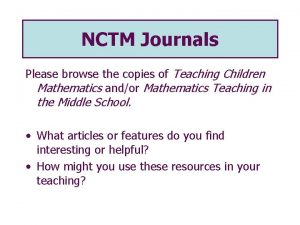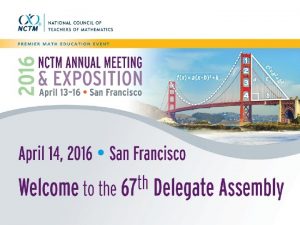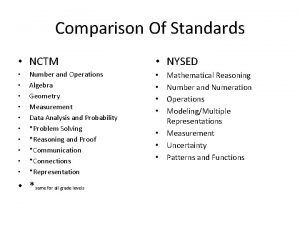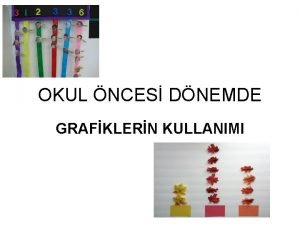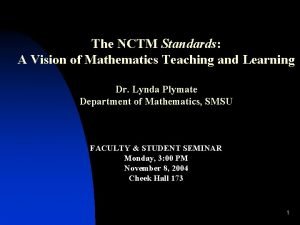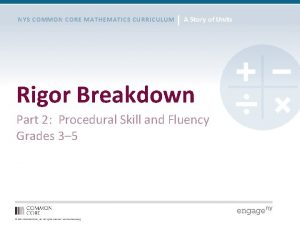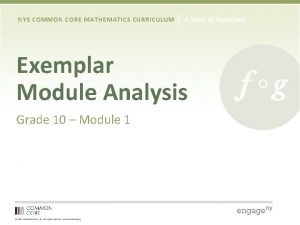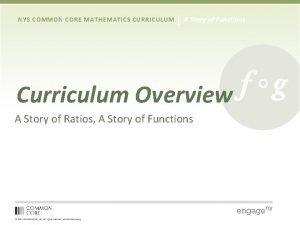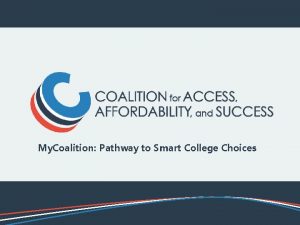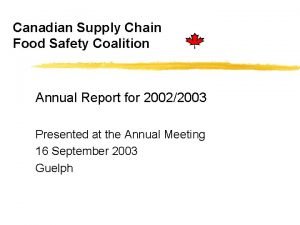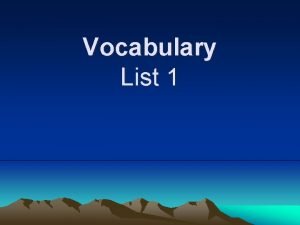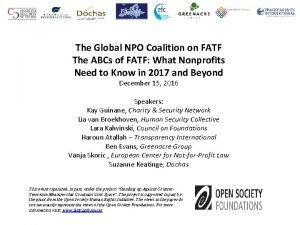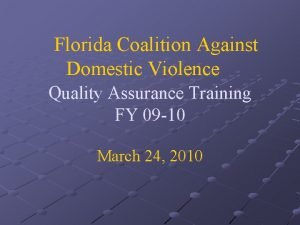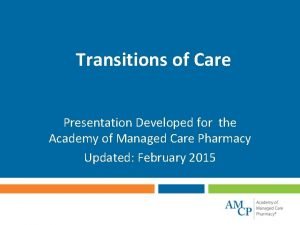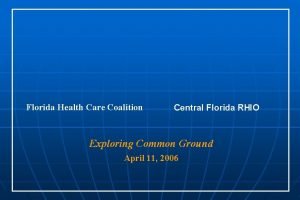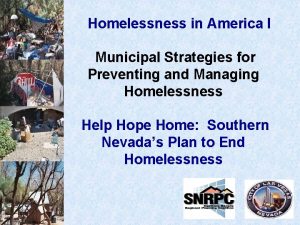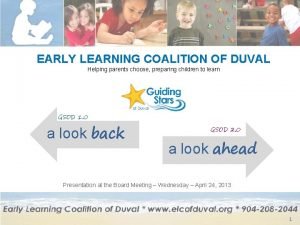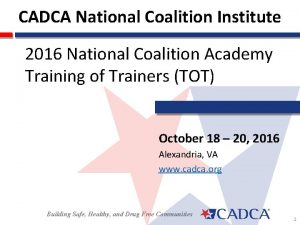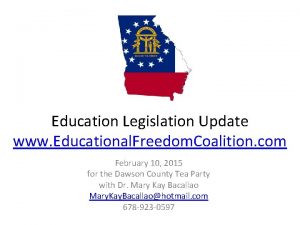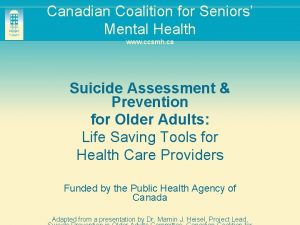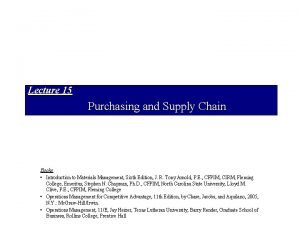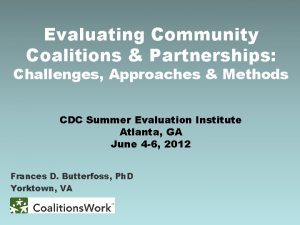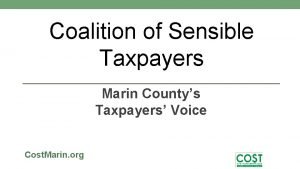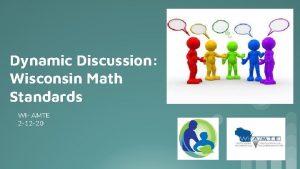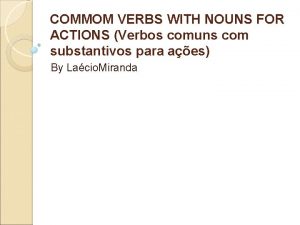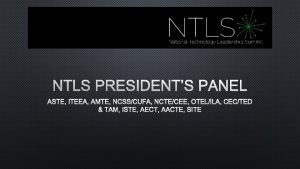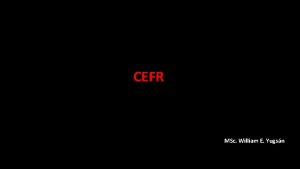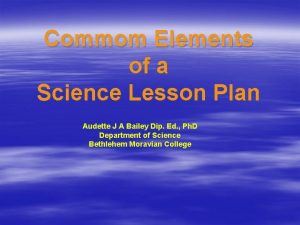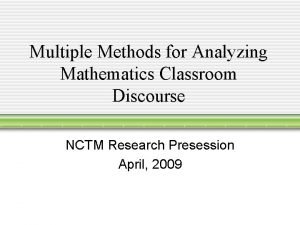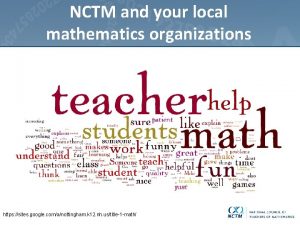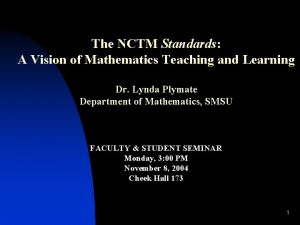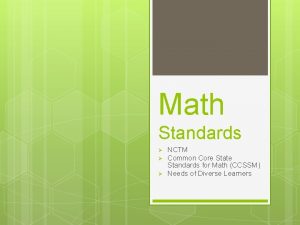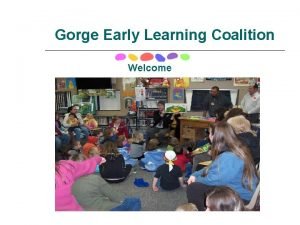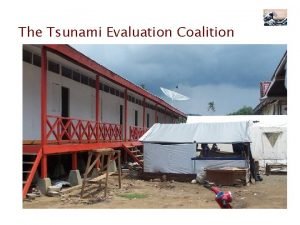MC3 Mathematics Commom Core Coalition NCTM AMTE ASSM













































- Slides: 45

MC^3 Mathematics Commom Core Coalition NCTM, AMTE, ASSM, NCSM, PARCC, SBAC, CCSSO, NGA

Presenters • • • Mike Shaughnessy, NCTM President Marilyn Strutchens, AMTE President Diana Kasbaum, ASSM President Doug Sovde, PARCC Suzanne Mitchell, NCSM President

National Council of Teachers of Mathematics J. Michael Shaughnessy President

Grew out of recommendations of Joint Task Force of 4 Math Ed organizations Mission: The Mathematics Common Core Coalition strives to ensure the successful communication, interpretation, implementation, and assessment of the Common Core State Standards.

Goals of MC^3 1) Provide a means to review, research, nurture and communicate common messages throughout the implementation and assessment of the CCSSM.

Goals of MC^3 2) Provide expertise and advice from the communities of mathematics education content and assessment experts for the development of the content frameworks of the assessment consortia for the CCSSM.

Goals of MC^3 3) Collect information about the implementation and assessment processes of the CCSSM that will inform future revisions of the CCSSM.

First steps • Establish a common ‘go to’ website for the Coalition that contains or links to all the information and resources that our various organizations are providing the public and our members about the CCSSM. Mathccc. org

First steps • Seek funding from an educational foundation to provide support for web development, meeting travel, and minimal staff support

NCTM Contributions to MC^3 • Making it Happen –Document that details how NCTM’s existing standards resources provide support for teachers, schools, districts, states in the implementation of Common Core Standards • Review and feedback on the initial drafts of both the PARCC and SBAC frameworks • Advisory team for Illustrative Mathematics Project (sample tasks illustrating CCSSM)

Association of Mathematics Teacher Educators (AMTE) Marilyn Strutchens, AMTE President October 4, 2011

About AMTE • AMTE's mission is to promote the improvement of mathematics teacher education. • AMTE is the largest professional organization focused on mathematics teacher preparation. • AMTE has about 1100 members. • AMTE is an active member of the Conference Board of the Mathematical Sciences (CBMS) (along with NCSM, NCTM, TODOS, Benjamin Banneker Association, …. . ) • AMTE is 20 years old, has 20 active affiliate groups, a mentoring program, a highly rated Annual Conference, and etc.

Provide guidance and resources for MTEs related to implementation of CCSS • Common Core Joint Statement • Joint Task Force on the Common Core State Standards (CCSS) Commissioned by AMTE, ASSM, NCSM and NCTM – Report of Priorities Identified and Actions Taken in Response to the Recommendations of the Task Force

CCSS-M Task Force CHAIR: M. Lynn Breyfogle, Bucknell University, PA Fran Arbaugh, Penn State University Sybilla Beckman, University of Georgia William Bush, University of Louisville Timothy Hendrix, Meredith College Beth Herbel-Eisenmann, Michigan State University Judith Jacobs, University of Michigan W. Gary Martin, Auburn University Sue Peters, University of Louisville Paola Sztajn, North Carolina State University in Raleigh;

CCSS-M Task Force • Charge is to: – Identify activities, materials and resources needed by AMTE members related to CCSS-M as they work with pre- and inservice teachers. – Prepare sample materials and identify others to be commissioned based on the needs of AMTE members. – Identify and compile existing resources related to implementation and critique of the CCSS.

Standards for Elementary Mathematics Specialists Developed by the AMTE EMS Project Team

Overview of the Initiative with Funding from The Brookhill Foundation • Developed guidelines for EMS program development and state certification. • Use the national leverage of AMTE (and other partnering organizations) to advocate for more states to offer EMS certification/ endorsements. • Sponsored a conference for state teams to attend who were interested in EMS certifications, June 2010. • Assembled an advisory board of different stakeholders. • Provided funding to help state teams to move EMS certification forward in their states. • Sponsored another conference for state teams to attend who were interested in EMS certifications, July 2011.

AMTE’s Sixteenth Annual Conference February 9 -11, 2012, Renaissance Worthington Hotel Fort Worth, Texas

Association of State Supervisors of Mathematics CBMS Forum Update MCCC Presentation Tuesday, October 4, 2011

What and who is ASSM? • ASSM is unique as it is the only professional mathematics organization whose membership is entirely composed of current or previous state or provincial supervisors of mathematics. • The organization serves as a network for state or provincial supervisors of mathematics • ASSM members are leaders in state and national efforts to improve mathematics education.

Reaching every state • ASSM is positioned to reach every State Education Agency (and every school district) in the United States and Canada • Through on-going communication and collaborative efforts, ASSM has the opportunity to help keep the common in the Common Core State Standards

Collaboration to implement CCSSM • ASSM members collaborate around implementation of the Common Core State Standards for Mathematics • Sharing resources – Google site – Listserv • Professional development efforts • Monthly web conference • Annual conference (prior to NCSM & NCTM) • Member involvement CCSSM initiatives

http: //assm. us/


ASSM members’ collaborative website

ASSM efforts to date • 2010 CCSSM Joint Task Force Report – Collaboration with NCTM, NCSM, AMTE, ASSM • 2011 ASSM responses to: – PARCC Model Content Frameworks (August 31, 2011) – SBAC Content Specifications (September 19, 2011

Other ASSM Involvement • ASSM collaborated in the publication of Ed. Thoughts: What We Know about Mathematics Teaching and Learning. • ASSM, as a subcontractor through NSF, administers the PAEMST recognition with mathematics coordinators in every state and jurisdiction • ASSM members are active in mathematics education initiatives in their states and provinces, as well as across the country.

2011 -12 ASSM Board of Directors President: Diana L. Kasbaum Wisconsin Department of Public Instruction Past President: Bradford Findell 1 st Vice President: Diana Suddreth Utah State Office of Education 2 nd Vice President: Sharon Mc. Cready Nova Scotia Department of Education 3 rd Vice President: Charlene Tate Nichols Connecticut State Department of Education Secretary: Carolyn Sessions Louisiana Department of Education Financial Officer: Charles D. Watson PAEMST Coordinator William Geppert

The Partnership for Assessment of Readiness for College and Careers

Partnership for Assessment of Readiness for College and Careers (PARCC) Governing Board States Participating States 30

Goal #1: Create High-Quality Assessments • To address these priority purposes, PARCC will develop an assessment system comprised of four components. Each component will be computer-delivered and will leverage technology to incorporate innovations. – Two summative assessment components designed to • Make “college and career readiness” and “on-track” determinations • Measure the full range of standards and full performance continuum • Provide data for accountability uses, including measures of growth – Two formative assessment components designed to • Generate timely information for informing instruction, interventions, and professional development during the school year • In ELA/literacy, a third formative component will assess students’ speaking and listening skills 31

Goal #1: Create High-Quality Assessments • Summative Assessment Components: – Performance-Based Assessment (PBA) administered as close to the end of the school year as possible. The ELA/literacy PBA will focus on writing effectively when analyzing text. The mathematics PBA will focus on applying skills, concepts, and understandings to solve multi-step problems requiring abstract reasoning, precision, perseverance, and strategic use of tools – End-of-Year Assessment (EOY) administered after approx. 90% of the school year. The ELA/literacy EOY will focus on reading comprehension. The mathematics EOY will be comprised of innovative, machine-scorable items • Formative Assessment Components: – Early Assessment designed to be an indicator of student knowledge and skills so that instruction, supports and professional development can be tailored to meet student needs – Mid-Year Assessment comprised of performance-based items and tasks, with an emphasis on hard-to-measure standards. After study, individual states may consider including as a summative component 32

Goal #1: Create High-Quality Assessments Flexible Early Assessment • Early indicator of student knowledge and skills to inform instruction, supports, and PD Summative assessment for accountability 33 Mid-Year Assessment • Performance-based • Emphasis on hard to measure standards • Potentially summative Formative assessment Performance-Based Assessment (PBA) • Extended tasks • Applications of concepts and skills ELA/Literacy • Speaking • Listening End-of-Year Assessment • Innovative, computerbased items

Goal #3: Support Educators in the Classroom INSTRUCTIONAL TOOLS TO SUPPORT IMPLEMENTATION PROFESSIONAL DEVELOPMENT MODULES K-12 Educator TIMELY STUDENT ACHIEVEMENT DATA EDUCATOR-LED TRAINING TO SUPPORT “PEER-TO-PEER” TRAINING 34

3 MC and PARCC: Partnering on Content and Engagement • To Date: • Critical contributor to early drafts of the content frameworks, as well as the public draft and subsequent revisions. • Substantive feedback on the original PARCC Assessment System Design • Educator Involvement Survey • Coming Up: • Thought partner on the following: 35 • Educator Leader Cadre Project; • Professional Development Modules; • College Ready Tools, including Bridge Courses; • High School Assessment Design Considerations and task reviews.

The Partnership for Assessment of Readiness for College and Careers August 2011 www. PARCConline. org Doug Sovde (dsovde@achieve. org)

NCSM RESOURCES THAT SUPPORT THE WORK OF MC 3: Suzanne Mitchell President, NCSM mathedleadership. org

National Council of Supervisors of Mathematics N-Network and collaborate with stakeholders in education, business, and government to ensure growth and development of mathematics education leaders. C-Communicate current and relevant research to mathematics leaders. S-Support and sustain student achievement through the development of leadership skills M-Motivate mathematics leaders to maintain a lifelong commitment to provide equity and access for all learners.


NCSM Support Materials – www. mathedleadership. org • 3 Tools for analyzing curriculum materials and related professional development activities – Collaboration with Bill Bush, University of Louisville, and CCSSO. – Released June, 2011. – NCSM webinar on implementation of the tools is forthcoming in November – Tools are on the NCSM website

Illustrating the Standards for Mathematical Practice Professional development materials on NCSM website: • Power. Point • Tasks and student work • Video clips Organized around sets of practices for grade bands

Insidemathematics. org

NCSM Webinars-online NCSM Webinars: • Getting Started with the Common Core State Standards: First Steps for Mathematics Education Leaders November 30, 2010 - 3: 30 to 4: 30 pm EST • Diving Deeper into the Common Core State Standards February 23, 2010 - 3: 30 to 4: 30 pm ES Sponsored by Carnegie Learning www. carnegielearning. com.

Mathedleadership. org

NCSM Professional Development Opportunities • NCSM Annual Conference – April 23 -25, 2012, Philadelphia, PA • NCSM Summer Leadership Academy – June 25 -27, 2012, Pittsburgh, PA – July 31 -Aug 2, 2012, Sonoma, CA • Fall One-Day Seminars – October 19, 2011, Atlantic City – October 26, 2011, St. Louis – November 2, 2011, Albuquerque
 Assm cyclo
Assm cyclo Commom goal
Commom goal Nctm articles
Nctm articles Illuminations nctm
Illuminations nctm Nctm affiliate leaders conference
Nctm affiliate leaders conference Nctm algebra standards
Nctm algebra standards Nctm standartları
Nctm standartları Nctm standards
Nctm standards Nys common core mathematics curriculum
Nys common core mathematics curriculum Nys common core math
Nys common core math Nys common core mathematics
Nys common core mathematics Core rigidity
Core rigidity The brittle, rocky outer layer of earth
The brittle, rocky outer layer of earth The crust the mantle and the core
The crust the mantle and the core Layers of earth from most dense to least dense
Layers of earth from most dense to least dense Georgia recycling coalition
Georgia recycling coalition Coalition clean baltic
Coalition clean baltic Communities in schools wv
Communities in schools wv My coalition
My coalition Canadian supply chain food safety coalition
Canadian supply chain food safety coalition Coalition in a sentence
Coalition in a sentence Rng coalition members
Rng coalition members Az housing coalition
Az housing coalition Checkmite active ingredient
Checkmite active ingredient Lara kalwinski
Lara kalwinski Time out steps
Time out steps Florida coalition against domestic violence
Florida coalition against domestic violence Eating disorder coalition of iowa
Eating disorder coalition of iowa National transitions of care coalition
National transitions of care coalition Florida health care coalition
Florida health care coalition Homeless coalition martinsburg wv
Homeless coalition martinsburg wv Iraq
Iraq Helphopehome
Helphopehome Michigan audiology coalition
Michigan audiology coalition Minnesota soil health coalition
Minnesota soil health coalition Self-driving coalition for safer streets
Self-driving coalition for safer streets Tennessee affordable housing coalition
Tennessee affordable housing coalition Guiding stars of duval
Guiding stars of duval National coalition academy
National coalition academy Freedom coalition for charter schools
Freedom coalition for charter schools Canadian coalition for seniors mental health
Canadian coalition for seniors mental health The japanese concept of a company coalition of suppliers is
The japanese concept of a company coalition of suppliers is Coalition evaluation for communities
Coalition evaluation for communities Coalition of sensible taxpayers
Coalition of sensible taxpayers Community coalition action theory
Community coalition action theory Global hiv prevention coalition
Global hiv prevention coalition


